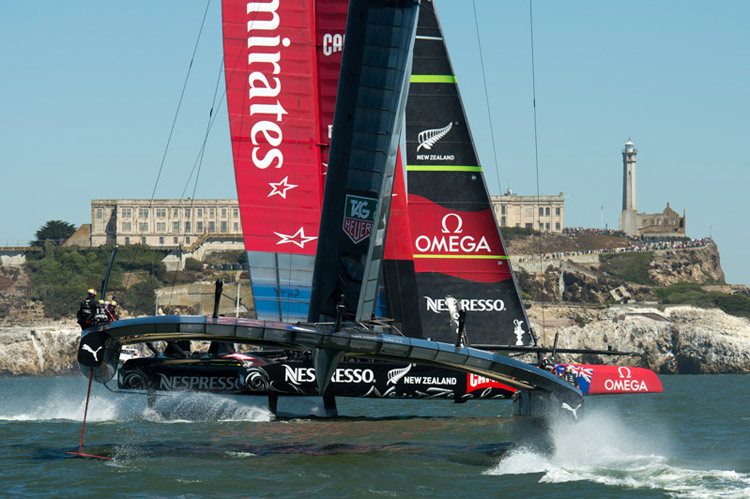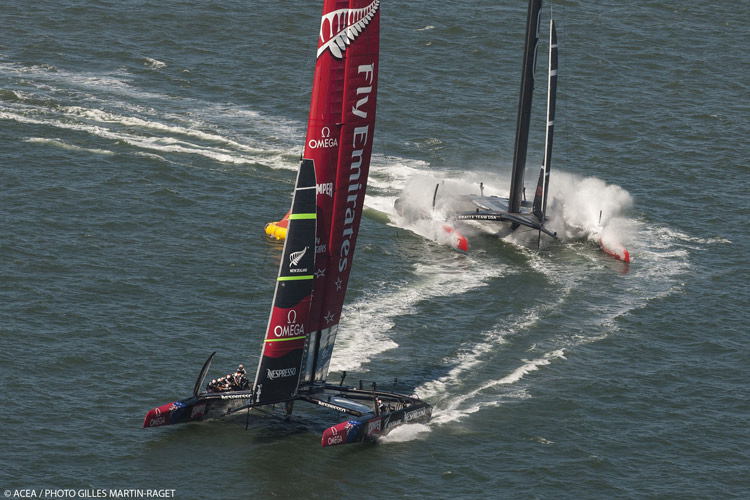Quotes and Wrap-Up: ETNZ Takes 2-0 Lead
Passes, Lead Changes, and Some Wild Match Racing Highlight
Races 1 and 2
San Francisco, September 7, 2013

Coming through. Image:�2013 Chris Cameron/ETNZ
The start of the much-anticipated 34th America�s Cup was everything that�s been hoped for: close racing between the two monster catamarans, numerous umpire decisions (all green flagged), trading paint and leads. But in the end, Emirates Team New Zealand proved to be the faster of the two radical AC72s, taking a 2 to -2 lead over Oracle Team USA.
After months of protocol point and counter-point, and weeks in which the Cup news cycle was dominated by accusations of cheating, the time had finally come to settle things on the water. To say that there is no love lost between these two teams is an understatement, but the first moments of race one went a long way toward silencing the critics of this new America�s Cup.
Race 1 saw both boats stay relatively far from each other on the pre-start. Oracle Team USA tucked to leeward of Emirates Team New Zealand with Jimmy Spithill trying for the luff on the short reaching leg but the Americans lost the overlap, giving Dean Barker the clear lead at mark one. After a couple of increasingly close crosses, the boats closed on the top mark with Oracle Team USA right on the Kiwis stern. Barker was slow coming away from the mark and this time Spithill was able to make the luff stick, sending Emirates Team New Zealand into a tack away. When the boats came back together, the Americans had made the gain and took the lead on the third leg. The Kiwis went back in front on the beat, clearly faster upwind than the Americans upwind. Rounding well ahead at the end of leg three, Emirates Team New Zealand never looked back, taking the first race by 36 seconds.
Race 2 began as a near carbon copy of race one, with Oracle Team USA trying to get the hook onto Emirates Team New Zealand at the start, from a much closer position than they�d had in race one. To leeward of the Kiwis and appearing to touch hulls, Spithill didn�t get the penalty call he was looking for at the gun. Both boats began from a standing start as Emirates Team New Zealand sprinted ahead with a two second lead at the reaching mark. Emirates Team New Zealand put the hard cover on the Americans, taking a seven second lead as Oracle Team USA had a small nosedive at the second mark that slowed them down. But in the end, the minor bobble wasn�t a factor, as the delta continued to increase between the two boats, with the Kiwis taking a commanding 52�second victory.
Dean Barker, Emirates Team New Zealand
We did an impromptu line up with them on Thursday, which was our first indication that it was going to be pretty close. It seems pretty even, from what we can see. It�s going to be a battle right to the end. When you get in tight racing like this, you all make mistakes and it�s going to cost you time.
James Spithill, Oracle Team USA
We had the Clysar starting to come off the wing. It was questionable whether we would race or not but the boys made a good call, that we could get around the racetrack and it wouldn�t stop us. It didn�t affect us at all.
There�s a lot we will learn from today. It�s the first time we�d really lined the two boats up and the look really similar. We just didn�t get as tight as we would have liked to on the first start and they were able to get over us at the reach mark. On the second one, we luffed tighter, waiting for the hook. We thought we were going to get a penalty, but it didn�t go our way. In the second race, there really weren�t any passing lanes, they did a great job and didn�t make any mistakes.
You�re seeing two very evenly matched teams and two very evenly matched boats. It will be the small little mistakes here and there that will decide the outcome of the race.
John Kostecki, Oracle Team USA
When you get behind, you want to try and get out of phase. When you do two tacks, you can get out of phase and gain an advantage over your competitor. In the first race, it was pretty nice on the city side, current-wise, and a lot of flood out in the middle. So it was better to be closer to shore.
I was surprised � in the two races, there were a fair amount of �Y� flags and not one penalty all day. We�ll look at the situations with our rules advisor and try to learn from them, learn the umpire�s thinking.
Glenn Ashby, Emirates Team New Zealand
You can lose a lot of ground really quickly. It�s tight racing and it�s hard, and we�ve got a lot of guys having to do their job really well. It doesn�t take much of a wobble to upset the apple cart. For two boats coming from entirely different design phase, production and set ups, to have the racing be so close is fantastic. But there�s a huge amount of racing to go and anything can happen.
These are two guys at the top of their game and they�re at the wheel of a $10 million carbon fiber missile. These guys are definitely in control, but it�s like a riding a motorbike or in a car -- you don�t know you�ve crashed it 'til you�ve crashed! In the decision-making process that these guys have, a split second is critical, it can make or break the boat very easily. Racing is racing, and so far, as we say in the AC45s, rubbing is racing as well, definitely for the shore crews. They�re used to the dings and scratches. The boats are very maneuverable, they�re very powerful and they accelerate and slow down very quickly. You have to be on your game.
-- Diane Swintal for CupInfo/�2013 CupInfo.com

Image:�2013 ACEA/Photo:
Gilles Martin-Raget
Additional Links and Info:
Daily Race Calendar for 2013 Louis Vuitton Cup and America's Cup
Also:
Visit America's Cup website